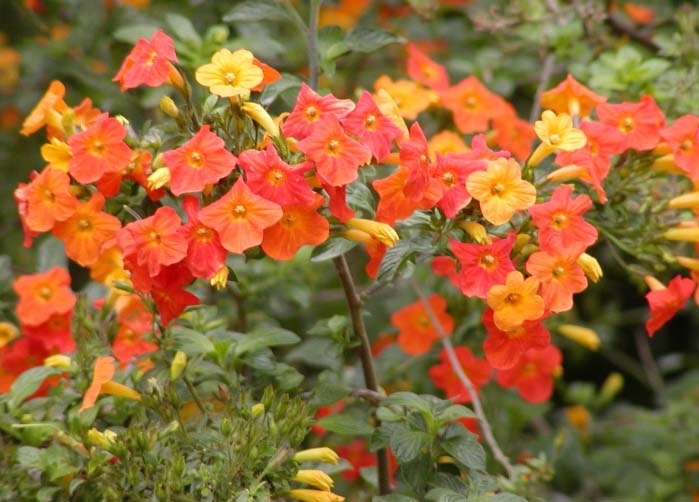Marmalade Bush
(Streptosolen jamesonii)
Marmalade Bush (Streptosolen jamesonii)
/
/

Stan Shebs
CC BY-SA 3.0
Image By:
Stan Shebs
Recorded By:
Copyright:
CC BY-SA 3.0
Copyright Notice:
Photo by: Stan Shebs | License Type: CC BY-SA 3.0 | License URL: https://creativecommons.org/licenses/by-sa/3.0 | Uploader: Stan Shebs | Publisher: Wikimedia Commons | Title: Streptosolen_closeup.jpg | Notes: User created page with UploadWizard |






























Estimated Native Range
Summary
Streptosolen jamesonii, commonly known as Marmalade Bush, is an evergreen shrub native to the cloud forests and shrublands of the Andes in South America. It typically grows to a height and width of 4-6 feet. The Marmalade Bush is known for its loose clusters of tubular flowers that transition in color from yellow to orange to red, resembling marmalade, hence its common name. The flowers are particularly showy, blooming nearly year-round in mild-winter areas, with peak flowering from February to July. The red hue of the mature flowers is characteristic of bird-pollinated species, which often lack strong scents and produce abundant nectar.
The Marmalade Bush is valued for its long blooming period and vibrant flower colors, making it an attractive addition to tropical and subtropical gardens. It is often used in mixed borders, as a specimen plant, or in containers. In cultivation, it thrives in part shade, requiring medium water and well-drained soil. While it is not a hardy plant, it can be overwintered indoors where temperatures fall below 7 °C (45 °F). The Marmalade Bush may attract hummingbirds, such as the short-tailed emerald, which pollinate the flowers while feeding on nectar. However, it can be susceptible to spider mites and whiteflies, especially when grown indoors or in dry conditions.CC BY-SA 4.0
The Marmalade Bush is valued for its long blooming period and vibrant flower colors, making it an attractive addition to tropical and subtropical gardens. It is often used in mixed borders, as a specimen plant, or in containers. In cultivation, it thrives in part shade, requiring medium water and well-drained soil. While it is not a hardy plant, it can be overwintered indoors where temperatures fall below 7 °C (45 °F). The Marmalade Bush may attract hummingbirds, such as the short-tailed emerald, which pollinate the flowers while feeding on nectar. However, it can be susceptible to spider mites and whiteflies, especially when grown indoors or in dry conditions.CC BY-SA 4.0
Plant Description
- Plant Type: Shrub
- Height: 4-6 feet
- Width: 4-6 feet
- Growth Rate: Moderate
- Flower Color: Yellow, Orange
- Flowering Season: Spring, Summer, Fall
- Leaf Retention: Evergreen
Growth Requirements
- Sun: Part Shade
- Water: Medium
- Drainage: Medium
Common Uses
Bird Garden, Hummingbird Garden, Low Maintenance, Potted Plant, Showy Flowers
Natural Habitat
Cloud forests and shrublands of the Andes in South America
Other Names
Common Names: Fire Bush, Marmalade-Bush, Orange-Browallia, Firebush, Gulltratt
Scientific Names: , Streptosolen jamesonii, Browallia jamesonii, Streptosolen benthami,
GBIF Accepted Name: Streptosolen jamesonii (Benth.) Miers